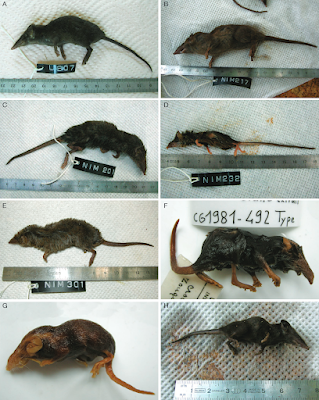In this study, we collected 226 shrew specimens originating from 16 localities on the Guinean and Liberian sides of Mount Nimba. We surveyed all major vegetation zones from 400 to 1600 m above sea level (asl), including forest and savannah habitats. We recorded 11 species, whose identifications were confirmed by genetic analyses and classical morphometrics. Furthermore, we provide cytogenetic data for five of these species. The shrew community at Mount Nimba is composed of a mix of both savannah- and forest-dependent species, which is related to the peculiar position of Mount Nimba situated at the transition between lowland rainforest to the south and Guinean woodlands to the north. We recorded 11 species of shrews in syntopy in lowland rainforest, seven in edaphic savannah and mountain forest, and five in high-altitude savannah at 1600 m asl. Based on morphometric analyses, we show that these syntopic species separate along a size axis, allowing species to occupy different ecological niches, which we speculate allows them to access different food resources. We also highlight that Crocidura theresae Heim de Balsac, 1968 from Mount Nimba has a different karyotype from that described in Côte d’Ivoire. Finally, we develop a novel identification key for shrews from Mount Nimba using external characters and standard body measurements, allowing it to be used in the field on live specimens. In total 12 shrew species are now known from Mount Nimba, which highlights its exceptional position as a tropical African biodiversity hotspot.
KEYWORDS: Soricidae, Crocidura, Suncus, community, cytogenetics, barcoding, morphometrics, morphology, Africa, Guinea, Liberia, biosphere reserve
Christiane Denys, François Jacquet, Blaise Kadjo, Alain Didier Missoup, Vladimir Aniskine, Joelle Goüy de Bellocq, Barré Soropogui, Mory Douno, Morlaye Sylla, Violaine Nicolas, Aude Lalis and Ara Monadjem. 2021. Shrews (Mammalia, Eulipotyphla) from A Biodiversity Hotspot, Mount Nimba (West Africa), with A Field Identification Key to Species. ZOOSYSTEMA. 43(30); 729-757.



